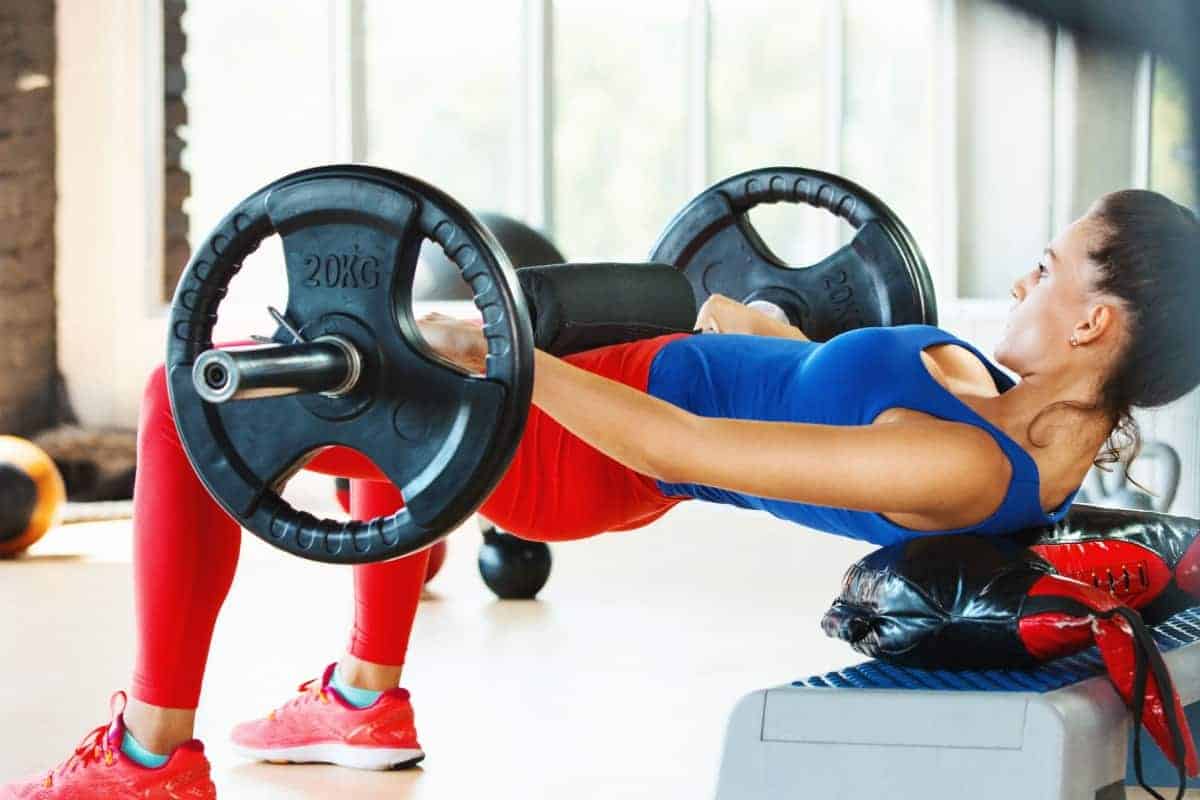This article aims to describe the main characteristics of the hip thrust exercise or hip push, the correct technique for its execution, the muscles involved in the movement, the most common mistakes when performing it, etc.
The hip thrust is one of the most used exercises to work the lower body due to the activation of the muscles involved in the movement.
The hip thrust is used for different purposes: improving sports performance, injury rehabilitation, hypertrophy, etc.
What is the hip thrust?
This hip push exercise is an exercise that consists of hip extension in a supine position.
One of the promoters of this exercise is Bret Contreras, an American researcher who has made several publications studying the possible effects of this exercise on sports performance (1).
Hip thrust: description
The hip push is a hip-dominant exercise, one of the main movement patterns of the human body. It is a global and multi-joint exercise that activates large muscle groups in the movement.
This exercise can be performed with different materials: with a barbell, with elastic bands, on a specific machine, using a non-specific machine to perform the movement, unilaterally, without material, etc.
How is the hip thrust done?
Next, we analyze the correct position for the hip thrust, we will see the technique to correctly perform the exercise; it is divided into the following phases (1,2):
Initial position
- The initial position of the person is sitting on the floor with the upper back supported on a padded bench or box.
- If the exercise is performed with a barbell loaded with plates, the performer will have to roll the bar over the legs until it reaches the hips.
- The feet are placed at hip or shoulder width and with the knees bent around 90º.
- It is recommended to place padding on the bar for heavy lifts to avoid discomfort in the hip bones.
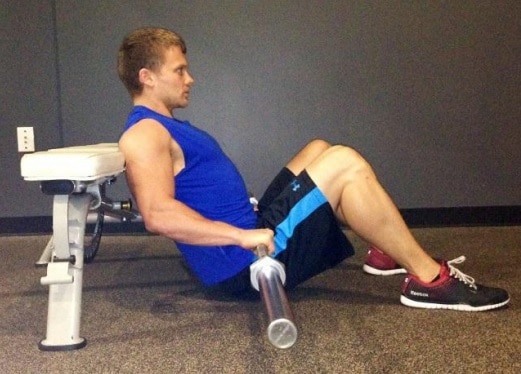
Hip push (concentric phase)
- Raise the glutes off the floor by performing a hip extension while maintaining the contact points of the feet on the floor and the scapular area on the bench.
- The head and spine must remain in a neutral position throughout the movement.
- The hip extension is performed until the body reaches a parallel position with respect to the floor.
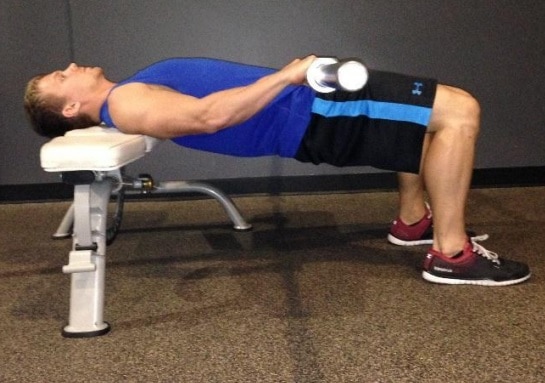
If you want a much more complete program you can download it below
Un completísimo programa para más de 6 meses de entrenamiento.
Conseguirás potenciar tus glúteos de forma eficiente y estilizar tu figura.
Return to the initial position (eccentric phase)
- Bend the hip slowing down the movement to generate an eccentric contraction of the muscles.
- The head and spine must continue in a neutral position also in this phase.
- Lower the hip until just before the glutes touch the floor to push up again. This way we perform a wide range of motion.
Common mistakes when executing the hip thrust
It is of vital importance to perform the exercises correctly to take advantage of their benefits and avoid injury. It is common to make the following technical errors when executing the hip thrust:
- If the goal of the exercise is to target the gluteus maximus, the legs must finish the movement with the knees bent at 90º. On the other hand, if the goal is to target the hamstrings, the hip movement will be performed with the knees more extended, so that the feet are in front of the knees in the final position (3).
- It is common to see flexion-extension movements of the head and spine. Since they do not intervene in the hip movement, their goal is to remain in a neutral position.
- Another common mistake is performing a hyperextension of the spine in the final phase of the push. This movement should be avoided to prevent possible injuries.
- A common mistake is not completing the full range of motion.
What muscles are worked in the hip thrust?
As we mentioned earlier, the hip push is a multi-joint exercise involving many muscle groups.
The muscles involved in this exercise are mainly:
- The primary hip extensors (gluteus maximus, hamstrings, and some fibers of the adductor magnus).
- The secondary hip extensors (adductors and posterior fibers of the gluteus medius and gluteus minimus).
- The spine stabilizers (erector spinae)
- The knee flexor-extensors (rectus femoris and vastus) (1).
The hamstring muscles (semitendinosus, semimembranosus, and the long head of the biceps femoris) are a biarticular muscle group, meaning they cross and intervene in 2 joints: the hip and the knee.
In the hip push, the hamstring muscles are at a mechanical disadvantage as they are already contracted by knee flexion, which means they cannot generate much force to extend the hip (1).
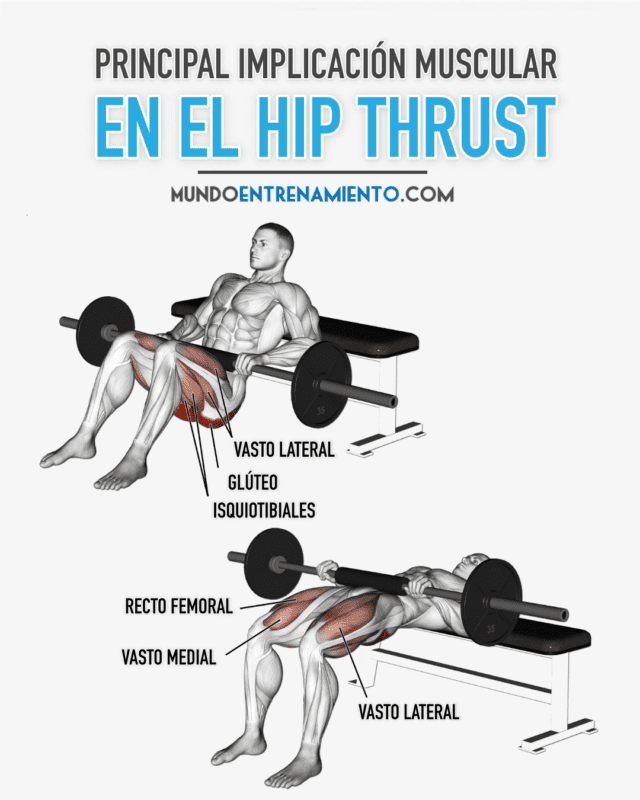
Neto W.K. et al. (2019) conducted a systematic review analyzing the hip thrust concluding that the exercise mechanics favor the muscle activation of the hip extensors compared to exercises like barbell squat, split squat, front squat, and deadlift (4).
Regardless of the type of hip thrust performed, muscle activation is always (from greatest to least) gluteus maximus, erector spinae, hamstrings, and quadriceps femoris.
Additionally, this exercise has a performance-enhancing effect in short sprints. To verify the effects on improving performance in longer sprints, more research is needed in this regard.
Andersen V. et al. (2018) studied the differences in muscle activation between the hip thrust with a barbell, deadlift with an Olympic barbell, and with a hex bar (5).
The gluteus maximus was activated more in the hip thrust than in the other exercises, while the erector spinae had similar activation in all 3 exercises.
Contreras B. et al. (2015) analyzed the differences in muscle activation of the gluteus maximus, hamstrings, and vastus lateralis between the hip thrust and the squat at 10 RM (6).
The results showed that both the gluteus maximus and the hamstrings were activated more in the hip thrust than in the squat, where the activation of the vastus lateralis predominated.
To conclude the analysis of muscle involvement during the Hip Thrust, we must cite the study by Barbalho et al. (2020) (9), where the effects of the back squat (ST) and Hip Thrust (HT) on muscle strength and hypertrophy were compared.
22 women were divided into two groups: one performed the squat exercise and the other, the Hip Thrust. The training program lasted 12 weeks.
Before and after the training period, participants were evaluated by measuring the thickness of the quadriceps femoris and gluteus maximus as well as performing a 1RM test in back squat and Hip Thrust.
Both groups significantly increased muscle strength in the 1RM of both exercises, however, the muscle mass increase in the ST group was greater than in the HT group, both in the quadriceps and the gluteus maximus.
The training performed by the ST group was more efficient than the HT, as it caused greater muscle hypertrophy and greater increases in the 1RM test of both exercises.
Technical variants of the exercise with influence on its muscle involvement
Researchers from the Polytechnic University of Madrid studied the differences in muscle activation with different technical variants of the hip thrust.
Collazo García et al. (2018) compared the following variants with the ‘standard’ hip thrust at 40% 1 RM (3):
- ‘Pull hip thrust‘: this variant consisted of performing a standard hip push in which the performer is asked to make an ‘intentional force’ in the movement. “Try to bring your heels closer to the glutes throughout the range of motion” is the instruction given to the participants.
- ‘Rotation hip thrust‘: the feet in this variant were placed further apart and participants were asked for an ‘intentional force to externally rotate the feet’. ‘Feel your feet rotate outward” was indicated to the participants. Foot rotation on the vertical axis was allowed as long as the distance between the feet was not modified during the movement.
- ‘Feet away hip thrust’: this variant is performed with foot support on the floor further from the bench, generating greater knee extension during the movement.
In the first variant, no significant changes were observed in the muscle activation of the hip extensors and knee flexors.
In the ‘rotation hip thrust‘ the activation of the gluteus maximus increased by 30% compared to the standard hip thrust, due to the incorporation of the abductor function of the gluteus into the exercise.
Therefore, it is effective to perform an ‘intentional rotational force of the foot’ during the lifts as it causes greater activation of the gluteus.
Finally, in the ‘feet away hip thrust’ variant, it was found that with more extended knees, the activation of the biceps femoris (+31%) and the semitendinosus (+38%) increased.
This greater muscle involvement is explained by the lesser knee flexion, which allows the biceps femoris and semitendinosus to generate more force in the hip extension.
Additionally, the muscle activation of the quadriceps decreases with this technical variant of the hip thrust, which modifies the hamstring: quadriceps ratio in favor of the hamstrings, something relevant in the prevention and/or rehabilitation of injuries.
Interactive test on strength training
Before continuing with the reading, we encourage you to take this test to test your knowledge about strength training. Do you dare? We anticipate that if you do it, you will have a final prize.
Single-leg hip thrust
One of the most used variants of the hip push is to perform it on one leg.
In this way, the activation of the hip stabilizing muscles increases to counteract the lateral tilt of the pelvis caused by the exercise.
This is why there is greater muscle work of the 3 glutes (maximus, medius, and minimus), tensor fasciae latae, erector spinae, and multifidus (7).
During walking or running, ground supports are performed unilaterally, requiring the activation of the hip stabilizers (gluteus medius and minimus) to keep the pelvis stable (7).
Therefore, the single-leg hip thrust is included in performance improvement programs or injury rehabilitation as it activates the muscles as it will in the actions of the sport performed or in daily life.
Progression in the hip thrust
The hip thrust is an exercise that can be easily modified to be performed by both beginner athletes and high-performance athletes.
Beginners who have barely worked on hip extension can start with a simpler exercise. This is the case of the two-leg glute bridge.
Once the person correctly performs the movement, they could progress by executing it on a bench to support the back, thus expanding the range of motion of the exercise.

When the person executes the movement without errors, the next step in the progression will be to add a load. Placing a bar on the hips, with or without plates, will be the ideal way to hold the bar safely during the lifts.
Another way to progress will be to perform the exercise unilaterally. To carry out unilateral work, the person must have previously worked on muscle strength as the muscle intensity is high in this type of exercise.

How can you add this exercise to your routine?
The hip thrust can be a very relevant exercise added to a full-body workout or a specific leg training day, providing you with benefits.
If you are performing hip pushes along with other leg exercises, such as squats and deadlifts, make sure to give yourself, and your legs, enough rest between workouts.
As always, make sure to have adequately warmed up before strength training. A moderate cardiovascular warm-up of 5 to 10 minutes, followed by some dynamic stretches and approach sets.
Course on Muscle Hypertrophy
If you want to learn more about the Barbell Row and how to get the most out of your workouts, we recommend our Course on Muscle Hypertrophy, based on the latest scientific studies.
En este curso vamos a tratar el entrenamiento de la fuerza orientada a la hipertrofia muscular, buscando las formas de optimizar el proceso a la hora de planificar las cargas y las sesiones de entrenamiento.
Aprenderemos a determinar cuándo nos interesa conseguir esa hipertrofia, cómo esta afecta a los niveles de fuerza y la importancia de conocer el estado inicial de la persona que se someta a este tipo de entrenamiento.
As humans evolved and began to walk upright on two legs, their glutes developed (1). However, due to today’s sedentary lifestyle, many people have inhibited, weak, and underdeveloped glutes (1). Therefore, the following article specifies the keys to optimizing glute training.
Anatomy and physiology of the glute
The glutes are made up of three muscles: gluteus maximus, gluteus medius, and gluteus minimus (1). Specifically, and connected with the article from Mundo Entrenamiento:
Gluteus maximus
The gluteus maximus is a very characteristic muscle of the human being that keeps the trunk upright and is one of the largest (1/3 of the buttock). It originates in the upper 2/3 of the external iliac fossa, posterior part of the sacrum, coccyx, sacroiliac ligaments, and the fascia that separates it from the gluteus medius and inserts into the external trifurcation line of the linea aspera and the fascia lata.
Its muscle fibers are superior abductors, inferior adductors, and all are extensors and external rotators. Its maximum efficiency is found at 90º of flexion, especially with knee flexion, as in this situation, the hamstring muscles are shortened. This muscle usually weighs approximately 850 g., more than the gluteus medius and minimus together (425 g.). This is where we will focus most in this work.
Gluteus medius
The gluteus medius is a muscle whose bilateral contraction stabilizes the pelvis and unilaterally elevates it (e.g., walking, climbing stairs, etc.). It is located in front of the gluteus maximus, originates in the iliac crest, and inserts into the external surface of the greater trochanter of the femur. It is a hip abductor and predominantly an extensor and external rotator.
Gluteus minimus
It also stabilizes the pelvis and is located in front and inside the gluteus medius. It originates in the anterior part of the external iliac fossa and inserts into the tip of the greater trochanter. It is an abductor like the previous two, although in it, unlike the previous ones, the flexor and internal rotator action predominates, in fact, it is the most important internal rotator. Its inferior fibers also produce external rotation and hip extension.
If you want a much more complete program you can download it below
Un completísimo programa para más de 6 meses de entrenamiento.
Conseguirás potenciar tus glúteos de forma eficiente y estilizar tu figura.
The SRA and MPS
On one hand, the SRA (Stimulus, Recovery, and Adaptation) is the primary principle that dictates how often glute training should be performed (2). On the other hand, the MPS is the muscle protein synthesis, which increases during recovery and adaptation (2).
Regarding the practical applicability of these two concepts, a series of points could be established (1,2):
- The type of exercise influences the time it takes to complete the SRA process. Therefore, it determines the management of training variables.
- Exercises have 4 aspects that influence recovery and adaptation time.
- Influenced by the proportion of muscle fibers.
Training organization
Next, we detail the organization of glute training.
Key 1: type of exercise
Firstly (1), there are a series of aspects (muscle activity, range of motion, eccentric emphasis, and muscle length at peak tension) that will determine the orientation of the exercise and the training itself (Figure 1).

Muscle activity
The muscle activity that occurs during an exercise is closely related to muscle tension production and recovery.
This muscle tension will be fundamental for stimulating muscle growth or maintaining muscle. Finally, it can be deduced that low muscle activation will cause low muscle tension, therefore, a small training stimulus, resulting in a short recovery time (and vice versa for maximum activation).
Range of motion
This aspect refers to the fact that muscles that cover large ranges of motion can develop greater muscle work, therefore, they will apply greater tension or force (and vice versa). However, this type of exercise will need more time to recover (and adapt), due to muscle wear from heavy muscle work.
Eccentric emphasis
Eccentric movements generate greater muscle damage than concentric exercises, and they also allow us to move a greater load. On the contrary, after these exercises, we will need more recovery time.
Muscle length at peak tension
Muscles produce greater muscle tension when they are elongated, compared to when they are shortened. By deduction, more time will be needed to recover and adapt.
Key 2: Training volume
Secondly, based on Israetel’s volume differentiations (3), some general recommendations can be given:
- Maintenance (MV): in almost all cases, just doing squats or work involving the quadriceps is more than enough to maintain muscle mass gains in the glutes.
- Minimum Effective (MEV): for most individuals, it is actually zero sets per week. But beware, these are direct work sets. Still, it can be specified around 0 and 4 total sets.
- Maximum Acceptable or Optimal (MAV): between 4 and 12 weekly sets on average.
- Maximum Recoverable (MRV): this element is around 16 sets. However, this upper limit should be individualized based on the individual’s characteristics.
On the other hand, depending on the type of exercise, repetitions per set will vary based on (2):
- Stretchers: 3-8 repetitions. High and medium loads.
- Activators: 8-12 repetitions. Medium loads.
- Pumpers: 12-30 repetitions. Low loads.
Key 3: Programming and periodization of glute training
Finally, the concepts of programming and periodization of glute training are associated with the principles of sports training. In this case, the Weineck model (4) has been chosen, which differentiates between principles of:
- The load: effective training stimulus, individualized load, increasing and varied load, alternation of loads, among others.
- Cyclical organization: continuous load, periodization of loads, and periodic regeneration.
- Specialization: age-appropriate and load specialization.
- Proportionalization.
Therefore, knowing that glute training volume is one of the most important variables (5), it would be appropriate to ensure a correct organization of loads over time.
For this reason, the meta-analysis by Schoenfeld, Ogborn & Krieger (6) concludes that working a muscle group twice a week resulted in greater muscle mass gains compared to once a week.
At the same time, Contreras (2) shares the statements mentioned above. Specifically, he says that “distributing 15 sets for a muscle over several workouts could make the muscle grow more than doing 15 sets all at once“.
Advanced glute training mesocycle
Next, we analyze an advanced glute training mesocycle:
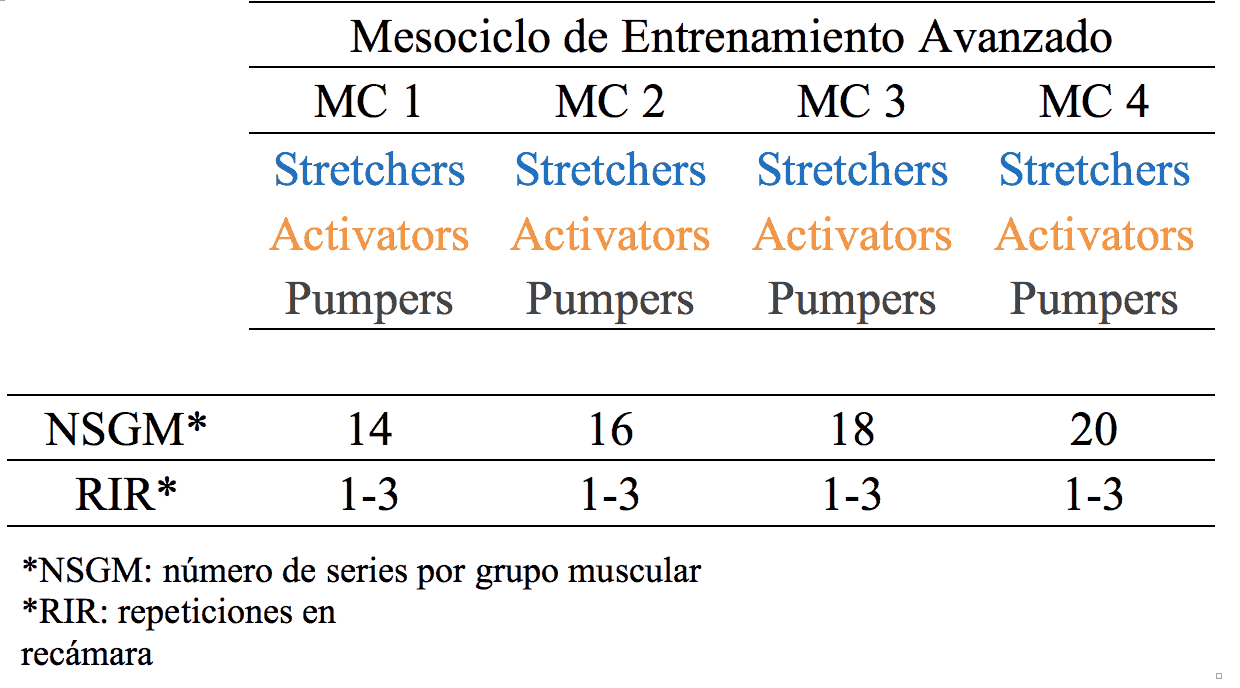
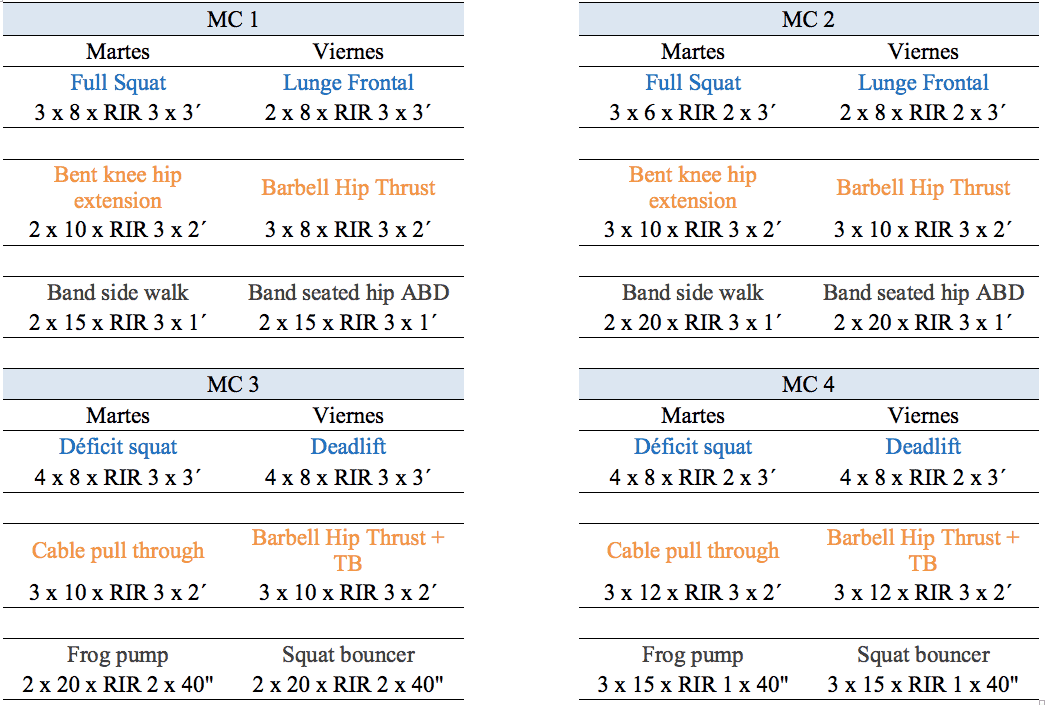
Conclusions on glute training
It is said that the gluteus maximus is the strongest and most powerful muscle in the human body. For this reason, it is logical to understand the most important training keys.
Therefore, it should be taken into account that the glute is made up of three muscles: maximus, medius, and minimus. At the same time, from a physiological point of view, this muscle group is directly influenced by the SRA and MPS, two very important variables for the organization of glute training.
Finally, the three most important training variables to optimize glute training can be highlighted. Firstly, the type of exercise (muscle activity, range of motion, eccentric emphasis, and length at peak tension).
Secondly, the most appropriate glute training volumes (maintenance volume, minimum effective volume, optimal volume, and maximum recoverable volume). And thirdly and lastly, the programming and periodization of training (training principles, importance of volume, and training frequency).
If you want a much more complete program you can download it below
Un completísimo programa para más de 6 meses de entrenamiento.
Conseguirás potenciar tus glúteos de forma eficiente y estilizar tu figura.
The hip thrust is one of the exercises where the glutes and hamstrings are most activated.
When performed correctly, this exercise is one of the most effective ways to add size and strength to your glutes. Additionally, it is an exercise accessible to almost everyone.
This exercise is carried out in hypertrophy programs, sports performance improvement (8), and injury rehabilitation.
Performing the hip thrust with feet further apart and with an intentional force of outward foot rotation increases the activation of the glute by 30%.
Placing the legs more extended leads to an increase in muscle involvement of the hamstrings.
Due to its great versatility, this exercise can be performed by both beginner and high-performance athletes.
The hip push or hip thrust is a perfect choice! as it strengthens the hip muscles, glutes, and quadriceps.
It also helps stabilize the pelvis, lower back, and knees, making it ideal for targeting low bone density in the hips and femur bones, aligning knee joints, and promoting strong glutes and better balance.
Podcast “Hip Thrust: The best exercise for your glutes”: Play in new window |
Subscribe to Apple Podcasts | Spotify | Google Podcasts |
Bibliographic references
- Contreras, B., Cronin, J., & Schoenfeld, B. (2011). Barbell hip thrust. Strength & Conditioning Journal, 33(5), 58-61.
- Eckert, R. M., & Snarr, R. L. (2014). Barbell hip thrust. J Sport Hum Perform, 2, 1-9.
- García, C. L. C., Rueda, J., Luginick, B. S., & Navarro, E. (2020). Differences in the Electromyographic activity of lower-body muscles in hip thrust variations. The Journal of Strength & Conditioning Research, 34(9), 2449-2455.
- Neto, W. K., Vieira, T. L., & Gama, E. F. (2019). Barbell hip thrust, muscular activation and performance: A systematic review. Journal of sports science & medicine, 18(2), 198.
- Andersen, V., Fimland, M. S., Mo, D. A., Iversen, V. M., Vederhus, T., Hellebø, L. R. R., … & Saeterbakken, A. H. (2018). Electromyographic comparison of barbell deadlift, hex bar deadlift, and hip thrust exercises: a cross-over study. The Journal of Strength & Conditioning Research, 32(3), 587-593.
- Contreras, B., Vigotsky, A. D., Schoenfeld, B. J., Beardsley, C., & Cronin, J. (2015). A comparison of gluteus maximus, biceps femoris, and vastus lateralis electromyographic activity in the back squat and barbell hip thrust exercises. Journal of applied biomechanics, 31(6), 452-458.
- Tobey, K., & Mike, J. (2018). Single-leg glute bridge. Strength & Conditioning Journal, 40(2), 110-114.
- González-García, J., Morencos, E., Balsalobre-Fernández, C., Cuéllar-Rayo, Á., & Romero-Moraleda, B. (2019). Effects of 7-week hip thrust versus back squat resistance training on performance in adolescent female soccer players. Sports, 7(4), 80.
- Barbalho, M., Coswig, V., Souza, D., Serrão, J.C., Hebling, C. M., Gentil, P. (2020). Back Squat vs. Hip Thrust Resistance-training Programs in Well-trained Women. International Journal of Sports Medicine. 41(5), 306-310. doi:10.1055/a-1082-1126.
